|
Monday, August 4, 2008
Progress Notes
The Miller County Museum is located very close to the Tuscumbia Cemetery on Highway 52. It is one of the earlier cemeteries in the county of any size although, certainly, local family cemeteries can be found which go back in time almost to the beginning of when people settled here. One area of the cemetery in the southeast corner is so old that at one time it had its own name, The “Burris Family Cemetery.” This part of the cemetery has had quite a bit of attention in years past due to the fact that Willis and Martha Burris, owners of the Burris Hotel in Eldon, are buried there. Peggy Hake has written on our website the story of the Burris family and their hotel and its association with the famous TV producer Paul Henning. You can find Peggy’s narrative at this location on our website:
http://www.millercountymuseum.org/commerce/hotels.html
For convenience, I will copy it here:
BURRIS HOTEL IN ELDON INSPIRED
"PETTICOAT JUNCTION" TV SERIES.....
By Peggy Smith Hake
At the turn of the 20th century, the Burris Hotel (once called the Rock Island Hotel), was a hustling, bustling hotel in Eldon, located near the railroad tracks of the Rock Island Line (photo 01).
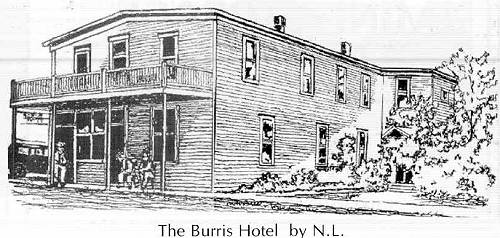
01 Burris Hotel
Willis Burris (born 1854) and Martha Bowlin (born 1862) operated this popular hotel. They married in Miller County circa 1879.
Their nine children spent many happy days there as they grew up keeping watch on the daily trains and passengers who were transported across Missouri with stops in Eldon.
The children included:
1. Alice Elizabeth Burris b. Oct 1883 m. Benjamin Barth
2. Delaney R. Burris b. Sep 1887
3. Opal A. Burris b. Oct 1889
4. Otis E. Burris b. Jan 1892
5. Anna E. Burris b. Feb 1894
6. Wallace M. Burris b. Apr 1899
Three other children were born after 1900.
Willis and Martha had lived in the Osage River country near Tuscumbia for a number of years but decided to move to Saline Township after their children were older. They operated three different hotels in Eldon over a period of years. One was the Godfrey Hotel at Second and Maple Streets; the Burris Hotel No. One at Mill Street and Old Highway 52; and the Rock Island/Burris Hotel near the railroad depot.
One of their daughters, Alice Elizabeth, grew up experiencing the hotel life in a small railroad town of Central Missouri. When Alice was grown, she moved to St. Louis where she met and married Benjamin Barth in 1908. Alice and Benjamin had a daughter, Ruth Margaret. As a young woman, Ruth moved to the Kansas City area and was employed by KMBC Radio. While there, Ruth met and married a young man from Independence, Missouri named Paul Henning.
The couple moved to the west coast in later years and Paul became involved in script writing for the movies and later for television.
In the 1960s, Paul Henning was inspired to write the television series called "Petticoat Junction", a down-home, popular series that American audiences loved. Paul's 'Shady Rest Hotel' in the show
was patterned after the hotel owned by Ruth's grandparents, the Burris/Rock Island Hotel in Eldon, Missouri.
Ruth’s mother, Alice Elizabeth Burris-Barth, had related to her so many wonderful stories of her life growing up in a small town near the Rock Island Line. Paul Henning, being a talented writer, brought his mother-in-law's memories to life and shared them with America. Paul and Ruth's daughter Linda Kaye Henning, the great granddaughter of Willis and Martha (Bowlin) Burris, portrayed one of the TV daughters in the "Petticoat Junction" series near the mythical town of Hooterville and greeted the daily train called the Cannonball which made trips through the town each day.
When Benjamin and Alice (Burris) Barth died, they were brought back home and buried in the Burris family cemetery plot in the Tuscumbia Cemetery. There are four generations of the Burris family there. The progenitor of this old Miller County family was Mastin Burris and his wife, Elizabeth. When Mastin died in 1844, he was placed in the family plot that was known as the Burris Family Cemetery located in the southeast corner of today's Tuscumbia Cemetery. Mastin's son, Miles Burris, had bought two town lots on the hill at Tuscumbia before 1844 from Isaac Goodrich for a family burial ground. Paul and Ruth (Barth) Henning had a rock wall erected around the gravesites of Ruth's ancestors after her mother's death in 1969.
Ruth Margaret (Barth) Henning died in 2002 and was placed at Tuscumbia Cemetery with her other family members. Her husband, Paul Henning, lived until 2005 and was also brought back to Miller County for burial. They were survived by 3 children: Carol Alice Henning, Linda Kaye Henning, and Paul Anthony Henning.
The old Burris Hotel, sitting for many years beside the Rock Island railroad in Eldon was torn down a few years ago, but the memories live on in each re-run of the "Petticoat Junction" television show.
NOTE: Paul Henning also wrote and produced 2 other popular shows for television including "The Beverly Hillbillies" and "Green Acres". The American audiences loved these down-home, small town shows and they can still be seen in re-runs on cable television networks.
Thanks Peggy. Here are some websites where you can get further informaiton about Paul Henning and the shows he worked on:
http://en.wikipedia.org/wiki/Paul_Henning
https://historicmissourians.shsmo.org/paul-henning/
Willis Burris was quite well known in the county. While originally from around Tuscumbia he also lived in Olean before moving to Eldon to run the hotel. A brief mention of him was recorded many years ago in the Olean Miller County News:
The Olean Miller County News
December 14, 1889
Willis M. Burris, Proprietor of the Olean livery stable, was born near Tuscumbia on March 10th 1855 (photo 03).
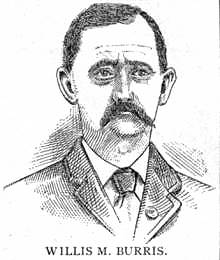
03 Willis M. Burris
He was born and reared on the farm and followed farming until three years ago. He received his education in the public schools and is an earnest church worker.
On the 10th of August 1896, he, in partnership with his brother, W.J., bought the livery stable at Tuscumbia, which they still own. In June of this year they bought the Olean livery stable and Willis moved here to take charge. He has one of the best livery outfits in Miller County and enjoys a large patronage from the traveling public.
Here is a family photo of the Burris family (photo 04):
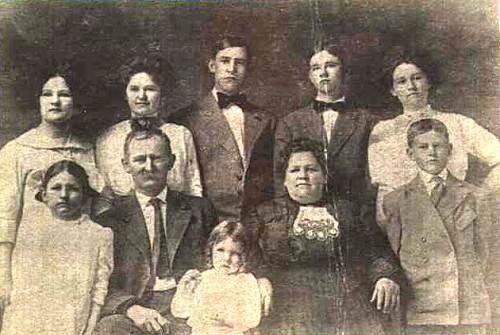
04 Willis Burris Family
And here are the names of the members of the family in the photo:
First row, left to right--Mattie Ellen Burris, Willis Mastin Burris, Tamar Hazel Burris, Martha Bowlin Burris, Wallace Miles Burris.
Second row, left to right--Oma Audrey Burris, Alice Eliza
Burris, Delaney Ray Burris, Otis Edgar Burris, Opal Adeline Burris. (c.1909).
As Peggy noted above, when Alice Elizabeth Burris Barth passed away, Paul and Ruth Henning donated money for an improvement of the Burris part of the cemetery. Here is an article from the Miller County Autogram about the improvements made:
Improvements Made At Tuscumbia Cemetery
Miller County Autogram Sentinel
Winter, 1969
Tuscumbia received a face lifting last week in the form of straightening and mending some of the leaning and broken headstones, refilling sunken graves, and in trimming up some of the drooping limbs of the large old cedars, especially in the southeast part of the cemetery, formerly known as the Burris cemetery.
The most noticeable addition was the erection of a rock wall along the south end, extending well around the corners, and for some distance along the southeast side of the cemetery. This was especially needed as a protection from trucks and busses which are housed and parked nearby.
The old Burris graveyard, in which four generations of the Burris family are buried, was at one time fenced separately. The oldest headstone noted is for Mastin Burris, born November 15, 1794; died November 4, 1844. The newest grave in this section is that of Alice Eliza Barth, buried there on September 10, 1969.
A contribution made by Mr. and Mrs. Paul Henning of Hollywood, California, son in law and daughter of Mrs. Barth, which Mr. Henning asked D.E. Kallenbach to administer, was used in building this section of the new wall and in the clean up and rejuvenation of this part of the cemetery.
The other section of the new wall was paid for from the regular cemetery fund.
Charley McDowell and his workmen of Lake Ozark did the work under the supervision of Kallenbach.
Here is a photo of Dewey and Charley at work (photo 05):
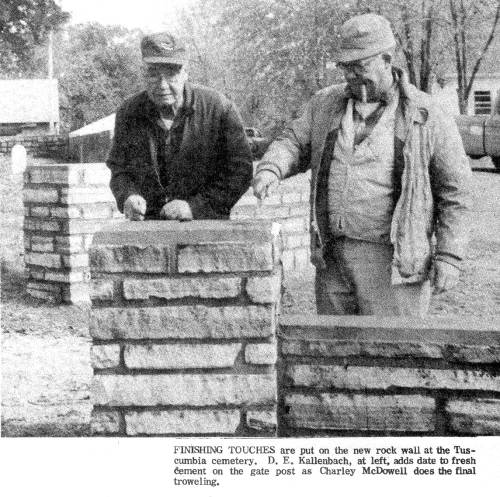
05 Dewey Kallenbach and Charles McDowell
Click image for larger view
Of course, since the Autogram article was written, both Paul Henning and his wife, Ruth, have passed away and both are buried in the old Burris part of the cemetery in Tuscumbia. As time passes along, younger generations won’t remember just how popular were the TV productions created by Paul Henning back in the 1960’s but the fact is, at one time, he was one of the most prolific Hollywood writers and producers. From a national perspective, he probably is the most famous person to have been buried in the Tuscumbia cemetery.
We have on file the obituary of Willis Mastin Burris, Ruth Hennings grandfather:
Obituary for Willis Mastin Burris
Willis M. Burris was born near Tuscumbia, Mo., March 10h 1855, and passed away at his home in Eldon, Mo., Dec. 11th 1926.
Very early in life Mr. Burris united with the Harmony Baptist church and his good life as a father and officer in the church is well known to all citizens of this section of the State.
Mr. Burris was married to Martha Bowlin, September 12, 1876. He leaves his widow, three sons, L. R. Burris, of Eldon; Dr. Otis Burris, of Ponca City, Oklahoma; Dr. Wallace Burris of Bixby, Oklahoma; five daughters, Mrs. Barth, of Kansas City, Mo., Mrs. Graham, of St. Louis, Mo.; Mrs. Weatherholt, of Eldon; Mrs. Jones, of Eldon, and Tamar; two sisters, Mrs. W. P. Berry, of Eldon, and Mrs. Sam Lawson, of Tuscumbia, and Mr. William Burris with a host of near relatives, survive him.
The funeral of Mr. Burris was from the First Baptist Church, of Eldon, Monday afternoon and the interment was at the Tuscumbia cemetery. All of his children and near relatives were here at the funeral.
The Reverend Magruder, former pastor of the Eldon church, very fittingly spoke of the life of this good man. The Reverend Magruder told it was not his custom to speak of the personal life of a departed friend, but Mr. Burris' life was so linked with his as former pastor of the church, that he wished to mention two outstanding qualities - "His power of Prayer" and "His ability to see the two sides of every question." These qualities, with many others, made Mr. Burris a splendid councilor and friend to all those who knew the good life. His liberal judgment made him first of all a friend of the young people as well as the older generation who knew him.
Mr. Burris has long been one of the most highly respected citizens of the county. He served the Baptist churches as an officer at the Harmony church in Tuscumbia, Olean, and Eldon.
Also, we have on file the obituary of his wife, Martha Bowlin Burris:
The Eldon Advertiser" March 17, 1932
Mrs. W. M. Burris Dies Here Saturday
Mrs. W. M. Burris, 70 years old and a resident of Miller County during her entire lifetime, died Saturday in her home in the Burris Hotel which she and Mr. Burris had managed for many years (photo 06).
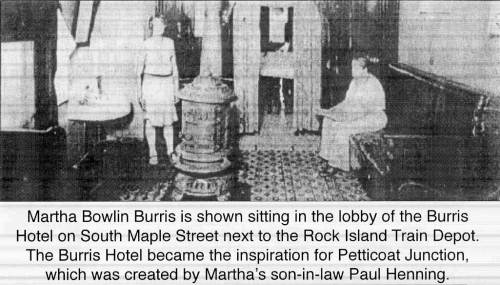
06 Martha Bowlin Burris
Click image for larger view
Funeral services were conducted at 2;30 o'clock Monday afternoon in the Baptist Church by the Reverend J. A. Roper. Burial was in the Tuscumbia Cemetery.
She was born near Bagnell on Jan. 10, 1862. On Sept. 12, 1927, she and Mr. Burris celebrated their Golden Wedding Anniversary. Mr. Burris died in December of that year.
Mrs. Burris has lived in Eldon twenty two years and was a member of the Baptist Church here. She is survived by three sons and five daughters, thirteen grandchildren, two brothers and two sisters.
Her daughters are Mrs. A. B. Barth and Mrs. L. M. Jones of Kansas City, Mrs. B. C. Graham of St. Louis, Mrs. H. E. Weatherholt and Mrs. F. S. Hunter of Eldon, her sons, Dr. Otis E. Burris of Ponca City, L. R. Burris of Eldon, and Dr. Wallace Burris of Bixby, Okla. Her brothers are J. M. Bowlin of Mounds, Okla., Dr. W. T. Bowlin of Mountain Grove, Mo.
Her sisters are Mrs. T. B. Bliss of Tulsa, Okla. and Mrs. H. W. Sandford of Tulsa, Okla.
Among those attending the services from out of town besides the family were Mrs. T. B. Bliss, Mrs. Chas. Saville, Fred Bliss of Tulsa, Okla., Dr. W. T. Bowlin of Mountain Grove, Mr. and Mrs. W. K. Hunter, & Paul Shelly of Versailles and Cadet Don Burris of Mexico Military School.
Tammy Witherspoon of the Eldon Advertiser wrote an article which included an interview with Mrs. Paul Hennng, Ruth Barth Henning. This article recently was reprinted in a magazine published by the Eldon Chamber of Commerce:
Eldon Was The Real Petticoat Junction
Tammy Witherspoon/Eldon Advertiser
(as published by Eldon Chamber of Commerce 2008)
“Come ride the little train that is rolling down the track to the Junction.
Forget about your cares, it is time to relax at the junction.
Lotsa curves, you bet, ‘N even more when you get to the junction,
Petticoat Junction!
There’s a little hotel called the Shady Rest at the junction,
Petticoat Junction!
It is run by Kate, come and be her guest at the Junction,
Petticoat Junction!
And that’s Uncle Joe, he’s a movin’ kinda slow at the junction,
Petticoat Junction!”
Note: Click HERE to listen to the theme song in the MP3 format. Also, you can visit the Wikipedia website located here for more about the Petticoat Junction show:
https://en.wikipedia.org/wiki/Petticoat_Junction
The above is the theme song to Petticoat junction, a series that ran on CBS from September 24, 1963 to September 12, 1970. It was a spin off of the popular TV show, The Beverly Hillbillies. The show revolved around a mythical railroad town called Hooterville and a hotel called the Shady Rest Hotel.
According to Petticoat Junction’s producer, Paul Henning, the show was based on the childhood recollections of his wife, Ruth.
In Ruth’s words: “My grandparents, Willis and Martha Burris had this hotel in Eldon, Missouri. It didn’t look anything like the Shady Rest Hotel, but it was right near the railroad station (photo 07).
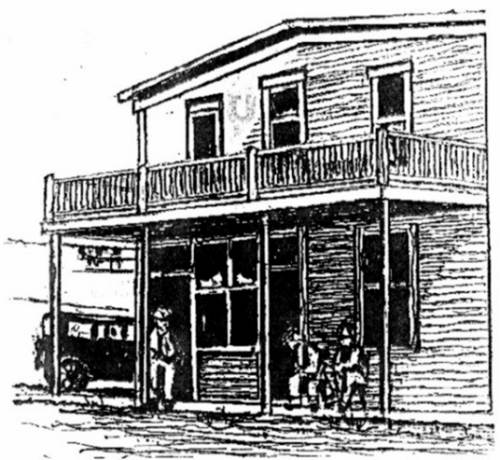
07 Burris Hotel - Front
Sometimes when I was a child, my mother would send me on the train out to visit my grandparents by myself, and she would pack me a lunch and pin the name onto my dress or something, and my grandpa would walk up to the station to meet me.
My mother was the oldest of five sisters, and all of them had girls, and we all went there for our summer vacations, and we really looked forward to it. Some of us older girls, the minute we would get there, we couldn’t wait to go uptown and go into the drugstore and have a Coke and give the local boys a chance to look us over. And when we got home, the telephone would start ringing and the boys would be wanting a date with one of the ‘city girls’.
“Of course, the Shady Rest was a much more beautiful place, all out in the country and everything. (The Burris Hotel) was right in (Eldon) and it wasn’t so beautiful, but my grandmother was a wonderful cook, and they served meals at the big long table in the dining room with bowls that they’d pass. A lot of people came there just to eat, even if they weren’t going to stay at the hotel.
Now, when I go to Eldon (I still have some relatives there) they practically have a shrine to the Burris Hotel. I’m a celebrity when I go down there because of Petticoat Junction. They say, ‘This is the Petticoat Junction hotel.’ The likeness was in the feeling of it. They were good country people, and everybody was very friendly.”
Ruth’s grandparents, Willis and Martha Bowlin Burris, moved to Eldon in 1910 after living in Olean and Tuscumbia. Willis operated a livery stable and also worked as a rural mail carrier. Martha managed a small hotel before the couple bought the Burris Hotel. Willis and Martha had a large family of four sons and five daughters. One daughter, Alice, married Benjamin Barth. The Barths lived in St. Louis and had two children, Marion and Ruth.
Ruth Barth moved to Kansas City and went into the radio business where she met Paul Henning. The Hennings’ daughter, Linda Kaye Henning, played the part of Betty Jo. At the opening of the show three daughters are shown swimming in the water tower. Linda said no one in the family actually knew whether any of the Burris sisters swam in the water tower.
Ruth wasn’t aware that her husband had taken note of her childhood recollections to the degree that he had, until one fateful day, which she describes vividly: “Paul said, ‘Well, Jim Aubrey is coming out to hear about my new program.’ Well, he always was good at having ideas, and I suppose he’d been kicking around ideas that I didn’t know about, but when Jim came out and came to his office, Paul adlibbed this idea about the widow with three daughters living in the country hotel, who took in traveling salesmen and people like that.
Of course, Jim was crazy about the idea. He said, ‘Go ahead. Get it going,’ and so, somehow or other, Paul got the pilot written, and I think he wrote about the first five shows, and then he hired some other writers.”
Shortly before the show’s debut, Paul held a press conference in his New York hotel suite. Ruth listened to Paul describe the show to the reporters and recalls his comments.”Fellas, this is about a way of life that is fast disappearing from the American scene. When people enjoy life, when they take time for each other, and when they’re kind to their neighbors and thy help each other out, it’s a nicer, better kind of life than you see mostly today.”
In 1963, a black and white Petticoat Junction (which originally was to have been called Whistle Stop) entered the CBS lineup on Tuesday evenings at 9 p.m.
Martha Burris died March 21, 1932. She operated the Burris Hotel for more than 20 years.
The following article is from a clipping in the Advertiser (the clipping I had didn’t give the date) which gives some more information about Paul Henning and his TV shows:
The city of Eldon was the inspiration for the 1960s television classic, Petticoat Junction, starring Bea Benadaret.
Creator Paul Henning patterned the sitcom, about a woman and her three daughters who run a country hotel, on tales told to him by his wife, Ruth.
Ruth Henning was the granddaughter of Willis and Martha Burris who used to run a hotel in Eldon in the 1940s. The hotel was situated close to the train depot that was built when the town was founded in the late 1800s. Ruth, who lived in Kansas City, used to visit her grandparents every summer. She and several of her girl cousins used to meet boys at the local drugstore.
According to the TV Guide website, while the Burris' hotel didn't resemble the fictional "Shady Rest" architecturally, the "atmosphere" was the same (photo 08).
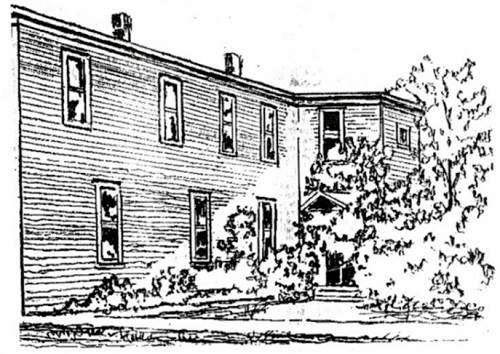
08 Burris Hotel - Side
Henning created Petticoat Junction, shortly after his first show, The Beverly Hillbillies, also based in the Missouri Ozarks, hit the airwaves.
When The Beverly Hillbillies proved to be a hit with audiences, network executives asked Henning to create something similar. Remembering the tales his then-finance, Ruth, had told him about growing up in Eldon, Henning wrote a pilot for Petticoat Junction. Petticoat Junction was such as instant hit that it finished fifth in the Nielsen ratings the first time it aired.
The show ran for seven years, remaining popular with audiences through several cast changes. It even managed to stay on the air for two more seasons after its star Bea Benadaret died of lung cancer.
In addition to The Beverly Hillbillies and Petticoat Junction, Henning also wrote and produced a third "country-themed" hit, Green Acres.
A spin off of Petticoat Junction, Green Acres starred Eddie Albert and Eva Gabor and was set in the rural area surrounding the fictional town of Hooterville, where the "Shady Rest Hotel" was located.
Here is a photo of Paul Henning in his library taken quite a few years ago (photo 09).
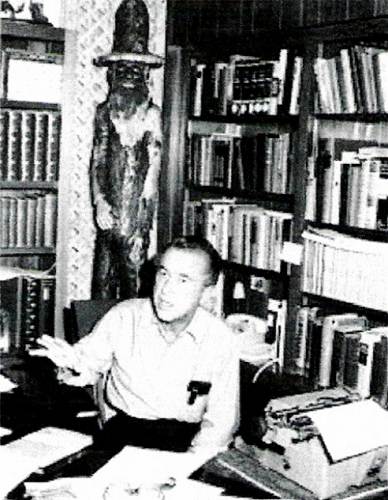
09 Paul Henning
Mike Wieneman, who was a personal acquaintance of the Hennings,supplied me all of the photos of Paul as well as the lithographs of the old Burris Hotel.
The following article from the AP gives more biographical information about Paul Henning at the time of his death in 2005:
Hillbillies Creator Dead at 93
The Associated Press
March 25, 2005
BURBANK, CALIFORNIA
Paul Henning, who created the hit TV show “The Beverly Hillbillies” and wrote its theme song, died Friday of natural causes, his daughter said. He was 93 (photo 11).
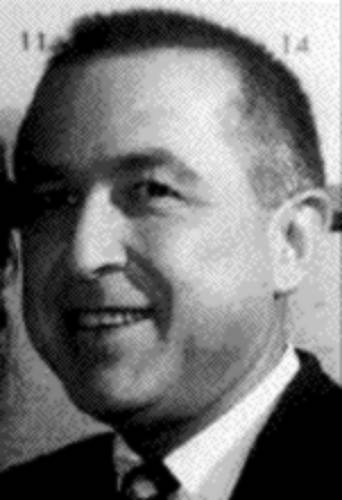
11 Paul Henning
Henning, who lived in Toluca Lake, died in a Burbank hospital. He created “The Beverly Hillbillies,” which debuted in 1962, based on his encounters with residents of the Ozarks during camping trips as a youth.
(Note: these camping trips Paul took were at the Lake of the Ozarks).
The CBS series starring Buddy Ebsen as the patriarch Jed drew up to 60 million viewers at its peak and ran until 1971. Henning also wrote the words and music to “The Ballad of Jed Clampett,” which was sung by Jerry Scoggins while Nashville bluegrass stars Lester Flatt and Earl Scruggs played guitar and banjo.
In 1963, he created “Petticoat Junction,” a “Beverly Hillbillies” spinoff.
Henning was born on a farm in Missouri on September 16, 1911 and graduated from Kansas City School of Law. He soon went to work, however, writing for radio, including “Fibber McGee and Molly” and “The George Burns and Gracie Allen Show.”
Henning also worked in films, writing the 1964 film “Bedtime Story,” starring Marlon Brando and David Niven. The film later served as the basis for the 1988 film “Dirty Rotten Scoundrels.”
During the ‘60’s, Henning brought the cast and crew of “The Beverly Hillbillies” to the Branson area for episodes of the series, filming at Silver Dollar City and attracting attention and thousands of visitors to the then developing theme park.
Later in his life, Henning and his wife Ruth donated land near Branson to the state for a conservation area, known as the Ruth and Paul Henning conservation Area, off 76 Country Music Boulevard.
One of Willis and Martha Burris’s children, Oma Burris, is pictured in the family photo previously displayed above (photo 04). She is first on the left of the second row. Oma’s granddaughter, Catherine Wolff, wrote and posted on the internet an interesting essay at the time of Oma’s death about her memories of her grandmother including some of her grandmother’s memories of the old Burris Hotel:
In Loving Memory of OMA BURRIS WEATHERHOLT
February 3, 1894 - April 18, 1978
by Catherine Wolff
There was a big, old walnut table in my grandparents' dining room. Around it the family would gather - the aunts and uncles, the grandchildren and cousins. We would feast on the best potato salad I've ever tasted, my grandfather's special biscuits and apple butter, lots of ham and chicken and Martha's German Chocolate Cake. After meals - and in between them - leaning over cups of inexhaustible coffee, the family would visit and catch up on each other's feelings and lives. Politics and movie stars, business and food, clothes and hairstyles would all be discussed passionately. But those topics would soon give way to family talk and memories.
Around this table, as a child and an adult, I learned a lot about my grandmother - Oma Burris Weatherholt. I learned how she grew up in Olean with nine sisters and brothers; I heard about the hard times, but never described, especially by my grandmother, with any bitterness. I learned how her father had a livery business that died with the horseless carriage and how later he and his wife ran a boarding house in Eldon.
At that hotel one summer, my grandmother met and fell in love with Harry Weatherholt. Sixty years later she remembered and told me clearly of the beauty of the sweet pea flowers that climbed up a fence that summer out back of the hotel.
Harry Weatherholt worked for the Rock Island Railroad and over the years that job and others took them to many different towns. My mother has told me how her mother would no sooner have gotten the curtains at the windows of their new home when it was time to move on again. My grandmother loved having a home, fixing it up, keeping it clean and full of love. But with all the moving, she never complained. It wasn't her nature. Eventually, they always would return to Eldon and no matter how far they went, the Burris family kept closely in touch. They were, and are, beyond blood, friends. They support each other - however they can - in times of crisis, births, joys, and deaths.
Hard times had cut short my grandmother's formal schooling, but when her daughters and niece brought home their studies, she would sit with them at the dining room table and learn their lessons as well as they did. Their friends quickly became her friends too, but she rarely tried to live her daughters' lives - only share them. That sharing continued with her grandchildren.
We lived in New York when I was a child, thousands of miles from Missouri. But whenever we could - at Christmas, Easter or in the summer - we would pile into a car or get on a plane and travel to gather around that dining room table.
Nine years ago, when I turned 21, I was a student at the University of Missouri in Columbia. Turning 21 usually meant a time to party. But, instead, I got on a bus that day and came to Eldon to sit around the table again with my grandparents. It wasn't out of a sense of duty. It was because I couldn't think of any two people I'd rather spend that day with and being with them always gave me a feeling of continuity - of a rich and full past that went far beyond my own life. And my grandmother gave me something else too - an outlook on life, a strength and a goodness that I hoped I also could achieve.
She loved life deeply and quietly. She wasn't the flamboyant type. She loved to visit new places, go to plays and movies, hear about books and ideas. And she loved people. She was a judging woman - she knew what was right and disliked what was wrong. But she never passed judgment. And she gave love unconditionally.
Around that dining room table, when talk turned to individuals, as it almost always did and somebody not present was getting a lot of criticism, my grandmother would sit quietly listening and then softly say something good about that person.
Almost everyone who met her loved her. She was a good listener and her spunk and sense of humor - which she learned eventually to direct even at herself - warmed all those who knew her. Her faith in Christianity also strengthened her. She never saved it only for Sundays, but tried daily to live a Christian life of giving, forgiving, and accepting whatever happened.
Her father used to tell her: "Keep your back straight and walk with pride." My grandmother lived that way. When her arthritis bent her back and later paralysis deprived her of walking, she still lived with that lesson in mind.
Oma Burris Weatherholt is not dead. She will continue to live eternally, but also through the people who knew her and through the family and friends who gathered around that dining room table over the years to share a cup of coffee.
April 22, 1978
Obituary Information: Oma (Audrey) Burris was born 3 February 1894, the daughter of Willis Mastin Burris and Martha Bowlin. She was the eighth of twelve children. On 4 March 1918 she married Harry Edward Weatherholt, the son of James E. and Ann Cowden Weatherholt. Harry was born 4 December 1887 and died 26 September 1972. Oma's death was on the 18th of April in 1978.
They are buried side by side in the Burris Family Cemetery, which years ago became a part of the Tuscumbia Cemetery, in Tuscumbia, Mo. Oma and Harry had two daughters: Willis Ann Weatherholt and Audrey Joan Weatherhold. Willis Ann married Thomas Morton Wolff and had three children Diane, Catherine, and Thomas. Audrey Joan Weatherholt married 1) William Herbert Rivers. They had three children: Tamara Joan, Daniel, and William Rivers and 2) Jesse Xavier Petit. They live in San Diego and have no children.
After putting together this narrative about the Burris family, their famous hotel in Eldon, and their relationship to the famous Hollywood producer Paul Henning, himself a native of Missouri, I decided to walk over to the cemetery and take a look at the Burris corner at the south east end.
It is strange to think that as a young boy I walked by this area everyday after school either on my way home or else to work in my father’s cedar wood craft shop which was located on the other side of the cemetery. But I never paid much attention to who was buried in that corner of the cemetery.
For sure, most of the grave stones were very old but the cemetery had many old gravestones and I didn’t think much about it. Of course, at that time, TV wasn’t even available to most people and certainly no one had ever heard then of Paul Henning, the Hollywood Producer. I took a picture of the stone entrance funded by Paul Henning and constructed by Dewey Kallenbach and Charley McDowell as noted above (photo 12).
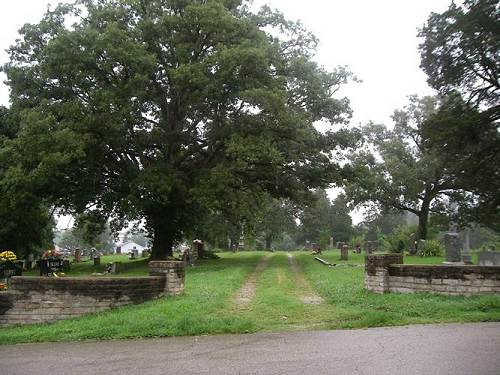
12 Cemetery Entrance
Then I walked around and to the rear of the southeast corner and took a picture of the Burris area which is located directly under a huge and very old cedar tree (photo 13).
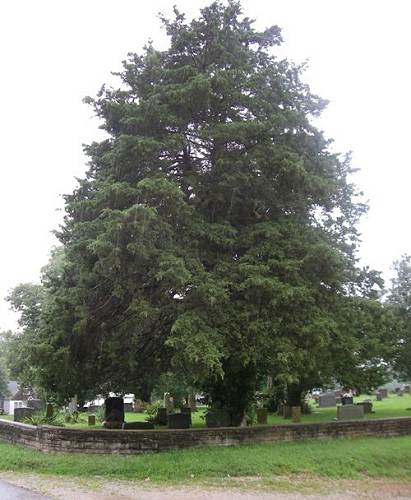
13 Burris area under big cedar tree
Here is where are located the tombstones of Paul and Ruth Henning (photos 14 and 15).
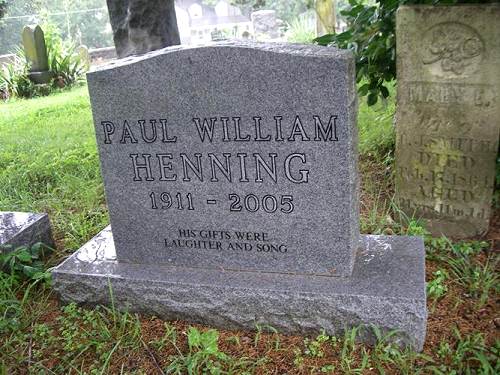
14 Paul Henning Tombstone
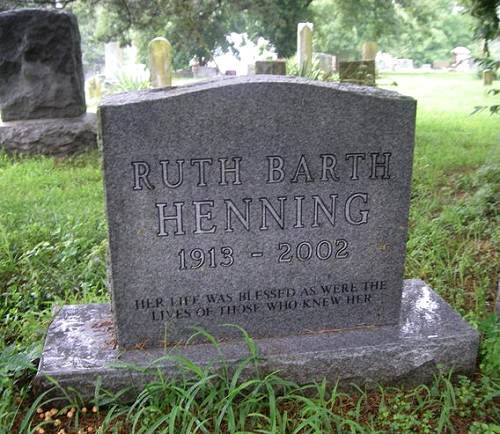
15 Ruth Henning Tombstone
Somehow, I kind of think it means something special that Paul and Ruth thought enough of our county and their memories of it that they chose to buried here.
The last couple of weeks I was on vacation during which time I had the opportunity to do some under water photography. Here is an anemone (photo 16)...
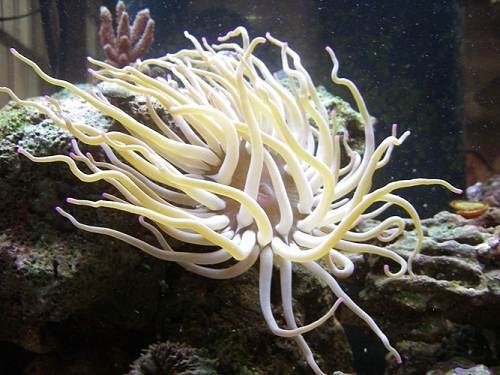
16 Anemone
And here is a colony of Zoanthids (photo 17)...

17 Colony of Zoanthids
Next are some green mushrooms (photo 18)...
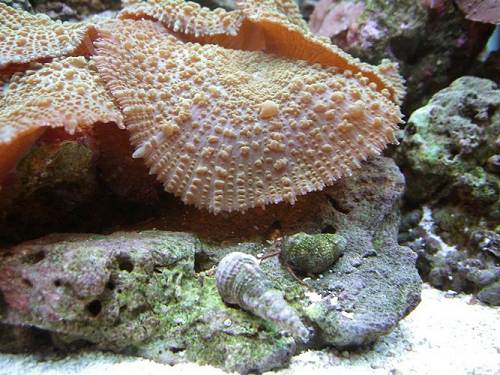
18 Green Mushrooms
And here is a red brain coral (photo 19)...
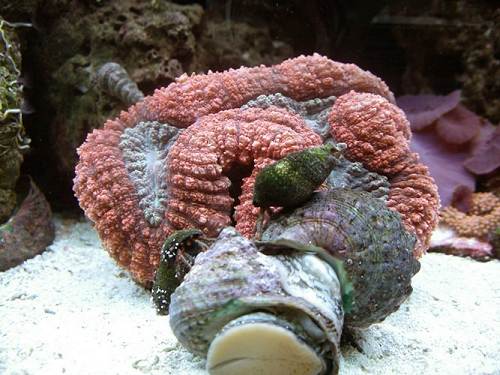
19 Red Brain Coral
Then I zoomed in on an opening in the coral formation (photo 20)...

20 Hole in Coral
And there suddenly appeared a smiling face (photo 21)!
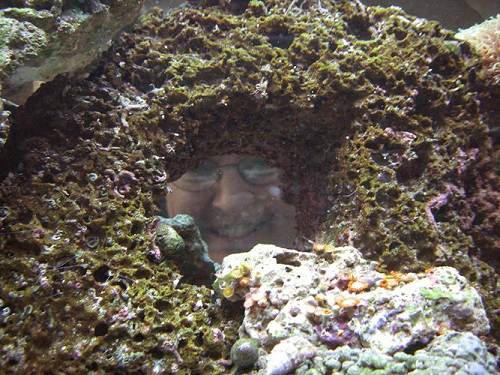
21 Smiling Face
I looked up from my camera and discovered that my wife, Judy, was looking at me from the other side of my son, John’s, aquarium (photo 22)!!
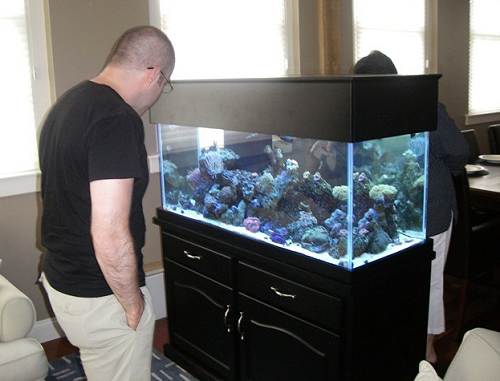
22 Judy looking through the Hole
Peggy Hake sent me this interesting email which is about the way women used to wash dirty clothes long ago before washing machines were ever invented:
Joe,
I received this delightful email a few days ago and it tells of the 'recipe' used to wash clothes long ago on a regular wash day for our mothers. I think it is so informative and downright amusing to know the hard work they put into a day of doing the laundry and then hanging them up to dry. Thought you might enjoy reading about them. I also remember my mother would use tall weeds/brush to lay clothes out to dry and sometimes would just droop them across a fence line! When I was rearing my children in the late 1950s and 60s I still used an old wringer-type washing machine with 2 rinse tubs off to the side. How wonderful the first time I received an automatic washer and it was several years before I got my first dryer!
Peggy
Never thought of a 'washer' in this light before..what a blessing!
'Washing Clothes Recipe' -- imagine having a recipe for this ! ! !
Years ago an Alabama grandmother gave the new bride the following recipe:
I can only imagine a young bride who said to her grandma she didn't know how to wash clothes and perhaps she just wrote it down for her.
This is an exact copy as written and found in an old scrapbook - with spelling errors and all.
WASHING CLOTHES
Build a fire in backyard to heat kettle of rain water. Set tubs so smoke wont blow in eyes if wind is pert. Shave one hole cake of lie soap in boilin water.
Sort things, make 3 piles
1 pile a white,
1 pile a colored,
1 pile a work britches and rags.
To make starch, stir flour in cool water to smooth, then thin down with boiling water.
)))))))))))))))))))))))))))))))))))
Note: I also remember using some kind of a 'bluing' liquid to brighten my white clothes (baby clothes, diapers, towels, wash cloths, sheets--mostly white also)---Peggy
(((((((((((((((((((((((((((((((
Take white things, rub dirty spots on board, scrub hard, and boil, then rub colored don't boil just wrench and starch.
Take things out of kettle with broom stick handle, then wrench, and starch.
Hang old rags on fence.
Spread tea towels on grass.
Pore wrench water in flower bed. Scrub porch with hot soapy water. Turn tubs upside down.
Go put on clean dress, smooth hair with hair combs. Brew cup of tea, sit and rock a spell and count your blessings.
============ ========= ========= ========= =========
Paste this over your washer and dryer Next time when you think things are bleak, read it again, kiss that washing machine and dryer, and give thanks. First thing each morning you should run
and hug your washer and dryer, also your toilet---those two-holers used to get mighty cold!
For you non-southerners -wrench means rinse. ;)
AND WE THOUGHT WE HAVE IT ROUGH!!
Thanks Peggy.
We have a display in the museum which contains some of the paraphernalia used for washing clothes before electricity or running water. I asked my mother to tell me what happened in her house on Monday mornings each week when she helped her mother do the washing and I will include some of the photos from the display:
Washing Clothes in the 1920’s
Susie Bear Pryor
This is how I remember our Wash Days every Monday morning at home. First Mom got every one out of bed; no lying in bed and coming downstairs for breakfast one by one (although the younger ones were excused from washing). For my part when I became of age which I think was around ten years old I had my special chores to do for the washing.
While I helped mom do the wash, all of us kids had other chores to do as well which I guarantee were needed. That meant that Arthur had to go open the doors at the store, Marie was to tidy up the house and change the sheets on the bed, David was to split the wood to make the fire under the important old black kettle out in the yard to heat the water to start the wash (photo 23), and then my chore was to get our 88 year old grandpa up.
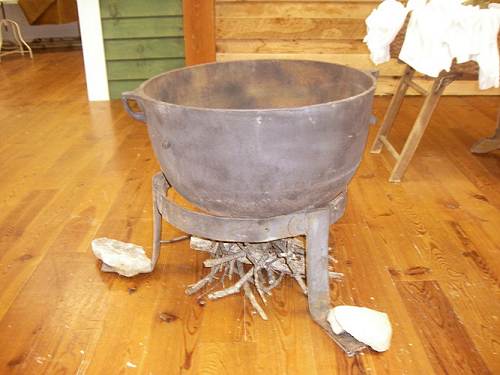
23 Kettle
I gave him his bath from head to toe, and he just stood there quietly not giving me any back talk for he knew he had to have a bath and get clean clothes on to be ready to start the new week. Then I brought him down to breakfast and he would sit at the table and drink coffee and eat several slices of toast which he sopped in the coffee until he had enough.
Bonnie, bless her heart was the only one left and because she still was too young she got to loll around in bed as long as she liked. All this time the fire was going real good heating up the water under the kettle to start the scrubbing of the dirty clothes, which Mom had gathered up from all parts of the house. I might also add that the wash water was taken from two huge barrels which were placed under the gutters so the rain water they caught was ready to use for the washing.
The soap Mom used was what we called Mama's home-made Lye Soap. It was used for everything from washing our hair to every thing else we needed soap for. It played a big part in our weekly chore of washing our dirty clothes. I never did make it but my older sister, Marie, made it all the time. The soap would vary in color, all the way from light to dark, and that depended on whether your grease had been saved from cooking or if your grease you used was fresh lard. Mom used both grease and lard but the lye which was added was important for that is what did the cleaning. We could buy the lye which came in a can at the store.
If you lived on a farm and butchered your own hogs you always had pieces of fat left over which wasn't used for eating except for 'cracklings'; and the rest was rendered to get the fat off the pieces that could not be used to eat. Well I might add that quite a few people ate the cracklings which were so popular they could be sold in the store just like potato chips are now.
I must explain here how you got 'cracklins'. When you were getting your hog butchered and cut up you separated all the large pieces such as hams, shoulders, etc. There were always small pieces left with some fat left on them and you cut off as much fat as you could separating it from the hide or skin left and this is what you called rendering the lard. By heating and cooking it all the fat turned to grease and all that was left was this fat and the hide or skin. When the hide and skin was cooked to a crisp light brown and salted it made a delicious snack called 'cracklins’. They were sometimes commercialized and sold in stores.
Well, now that gets us started off for everybody was now in their place and the big chore was started. Mom had a big metal tub for the scrubbing of the clothes and one for rinsing. The hot water was taken from the big black kettle and added as needed to the wash tub. As the water cooled down more hot water was added to the tub where the clothes were being washed. Mom did all the scrubbing; I guess she didn't trust any of the rest of us to get the clothes clean. She took her scrub boards and rubbed the clothes up and down on the metal part which was corrugated cross-ways, and then she rubbed the bar of soap over the garment after which she turned the garment over so that the soaped side was facing the corrugated wash board and rubbed up and down some more.
Then came the hard part for she had to ring the water out by twisting and squeezing the clothes until all the water came out as much as possible after which she tossed the clothes over into the rinse tub to get the soap out. Some people had a mechanical ringer worked by hand (photo 24) but we didn’t have one.
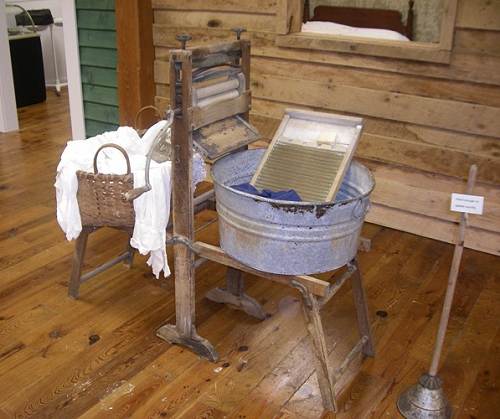
24 Ringer
We didn't heat the rinse water for now the clothes were scrubbed clean. But before the wash was finished we always had to keep adding clean hot water to the clothes for the scrubbing process. As Mama finished each piece she put it over in the rinse and I was standing there to rinse them but I wasn't strong enough to get all the water out. So she had to help me to get them wrung out and then she dropped them in a basket which I carried out to the clothes line to hang them on the line while she continued cleansing and rinsing. But I had to take a rag and clean the line first. When I got through hanging the clothes in my basket she had another basket ready to be hung and I just stayed at the line and didn’t rinse anymore. This same process was kept on until all the clothes were on the line.
But it was a very important task of getting those clothes hung on the line in just the right way, almost becoming a work of art, for they were not to be hung up in any kind of haphazard way. There was a method to it and I had to learn the way exactly as Mom taught me how. Your wash on the line was noticed by all your neighbors and it was important that they were viewed hung-up in their rightful place on the line and in just the right way. As Mom was scrubbing she also had an order of washing because white clothes came first, then towels and tea towels.
These last were put in the black kettle to boil awhile with the soap cut up in them and left there for awhile to brighten them up. They were punched around every once in awhile with an agitator to be sure and get all the parts soaked (photo 25).
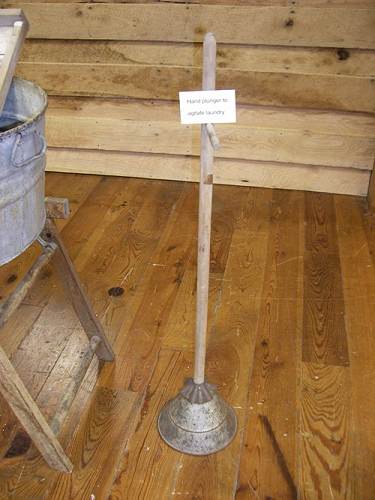
25 Hand Plunger Agitator
As I remember they were the only ones that were put in the kettle to soak. Then they were rinsed and a little bluing was put in the rinse water which whitened the clothes (photo 26). These white ones were put on the line first and also clothes that were the same were hung together.
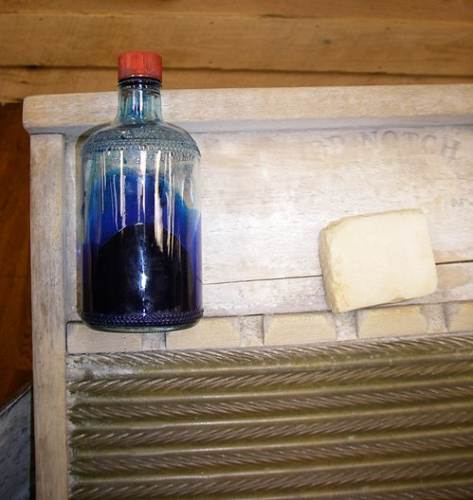
26 Mrs. Emerson's Blueing and cake of Lye Soap
Then the next load would be the colored ones which were hung next to the white ones and then on to the dark clothes such as pants and overalls. By that time my Mom was worn out with all that scrubbing and wringing out. Mom had shown me just how to take the clothes pins and pin the next piece together with the one hanging already hanging there so there would be a continuous line until every thing was pinned on the line. This also helped to save on the amount of clothes pins you had to use. The clothes pins were all hung in a bag which was hanging down from the line and you pushed it along with you as you finally got them all hung. Each garment was placed together with their same like-kind. Socks were neatly placed together with their mate.
It seems in the summer time we had a larger wash so in the summer time we spread some of the tea towels and other things on the grass so that the sun shining down on them would help them whiten some more. That would also save space on the lines so you would sure have enough room.
As I was pretty young when I took over my place in the big job of the weekly wash, I had to learn all this over time and not in one lesson. But I will say that thank goodness when I grew up and got married it wasn't too long until the prized electric washing machine was invented that had a motor to twist and turn the clothes and then you had to put each piece through the wringer to roll it through to the other side which was caught in the basket and ready to hang out. You can imagine how grateful all the women were when we could graduate from the way we had been doing them.
But I must add that the final chore from washing was due to the fact that we utilized everything. My Mom had us help her carry all the water used in the process of washing out to all the flowers she had growing in the yard and poured it out on them. Why they didn't die from all that home-made soap I'll never know but they didn't. Everyone was glad when Monday was over and when the clothes had dried on the line they were brought in the house and folded up and put in their right place to be used the following week.
The clothes to be worn were dampened down to be ironed. The dampening down helped them to get all the wrinkles out when the heated iron smoothed them all out. Usually we waited until the next day, which was Tuesday to iron them. Until I got older it was my chore to iron what Mom called the dry clothes, which were separate from the dampened clothes. It was my job when I was younger to iron the dry clothes, even the socks, but I can assure you that when I grew up and had my own family I eliminated that part of the chore of ironing the dry clothes.
All the cotton clothes had to be starched before they were ironed. Mom had me make the starch by mixing flour and cold water and stirring it after which I added hot water and cooked it until it thickened. I had to make it every week. I remember I had trouble keeping the lumps out using flour but later on when we used corn starch it was easier. I dipped the clothes to be starched in the starch and let them dry after which I sprinkled some water on them and rolled them up tight. After letting them set then I ironed them. But we didn’t have electricity so the irons had to be heated on the stove (photo 27).
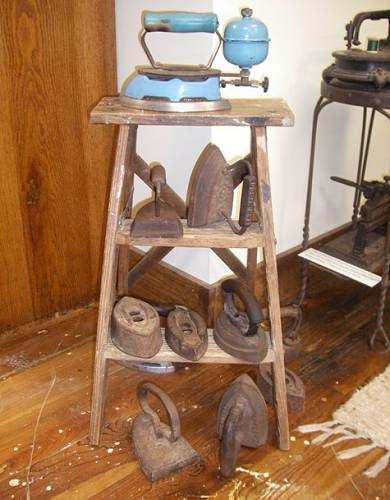
27 Old Iron Collection
Now that was the way Mom handled her weekly wash way back in the twenties. Thanks to electricity things came along to make washing easier like the agitator washer with the ringer. And then the automatic washing machine was invented which took care of the whole wash from the time you put the dirty clothes in the machine until it carried them through to the end of the cycle. Then you lifted them from the washing machine and placed them in an automatic dryer which would tumble them until they were dry and that finished your wash. To me those two automatic machines helped me the most of any household item made back in those times. But the greatest invention of all was getting electricity which enabled the housewife to use these machines which eliminated the laboriousness of these jobs in the home.
However, I will end my story by saying that my Mother ended up in the end by developing Parkinson's Disease but not before she taught all her kids how to wash the old-fashioned way.
I've just got to include here an earlier time which I thought was even more difficult than the way my mom did the washing. I was big and old enough to realize what a much larger chore my Aunt Dora Wickham had in getting her weekly washing done. She had to carry all her clothes down to a creek which ran through her farm located over toward St. Elizabeth. She had 5 kids and her husband and his parents to wash for. However, the kids ranged all the way from a baby up to somewhat older and as far as I can remember none of us helped her. But I did go down to the water's edge and saw her washing there on the bank. None of us stayed or helped her in any way. We just went on our merry way playing and doing what kids do. But that sight I saw down there was impressed on my memory when I think back about all the things she had to do to get that job all done.
Thanks Mom.
The last essay about old time washing was sent to my mother last spring by Carolyn Patterson Pryor. I’m not sure where she got it but here it is:
The Clothes Line
Do you remember?
The clothes line....a dead give away. Do the kids today even know what a clothes line is?
For all of us who are older, this will bring back the memories:
THE BASIC RULES
1. You had to wash the clothes line before hanging any clothes. Walk the length of each line with a damp cloth around the line.
2. You had to hang the clothes in a certain order and always hang whites with whites and hang them first.
3. You never hung a shirt by the shoulders, always by the tail. What would the neighbors think?
4. Wash day on a Monday...........never hang clothes on the weekend or Sunday for heaven's sake!
5. Hang the sheets and towels on the outside lines so you could hide your 'unmentionables' in the middle.
6. It didn't matter if it was sub zero weather.....clothes would freeze dry.
7. Always gather the clothes pins when taking down dry clothes. Pins left on the line was 'tacky'.
8. If you were efficient, you would line the clothes up so that each item did not need two clothes pins, but shared one of the clothes pins with the next washed item.
9. Take the clothes off of the line before dinner time, neatly folded in the clothes basket and ready to be ironed.
10. IRONED??????????
Well, that's a whole other subject.
A POEM
A clothes line was a news forecast
To neighbors passing by.
There were no secrets you could keep
When clothes were hung to dry.
It also was a friendly link
For neighbors always knew
If company had stopped on by
To spend a night or two.
For then you'd see the 'fancy sheets'
And towels upon the line;
You'd see the 'company table cloths'
With intricate design.
The line announced a baby's birth
To folks who lived inside
As brand new infant clothes were hung
So carefully with pride.
The ages of the children could
So readily be known
By watching how the sizes changed
You'd know how much they'd grown.
It also told when illness struck,
As extra sheets were hung;
Then nightclothes, and a bathrobe, too,
Haphazardly were strung.
It said, 'Gone on vacation now'
When lines hung limp and bare.
It told, 'We're back!' when full lines sagged
With not an inch to spare.
New folks in town were scorned upon
If wash was dingy gray,
As neighbors carefully raised their brows,
And looked the other way..
But clotheslines now are of the past
For dryers make work less.
Now what goes on inside a home
Is anybody's guess.
I really miss that way of life.
It was a friendly sign
When neighbors knew each other best
By what hung on the line!
Thanks Carolyn.
I want to thank Mike Wienemann for the photos of Paul Henning and many thanks also go to the fellow who sets up my narratives and photos each week for the website, David Statler, of Jefferson City. I think he does an excellent job especially concerning revisions and additions from web research he has done. He, for example, is the one who found and uploaded the audio clip of the Petticoat Junction theme song.
That's all for this week.
|



